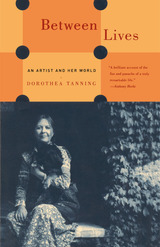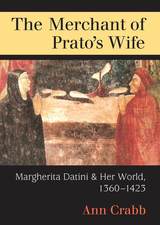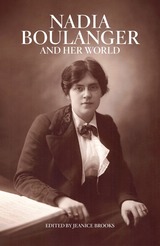4 books about Her World

Between Lives
An Artist and Her World
Dorothea Tanning
Northwestern University Press, 2003
Dorothea Tanning, one of the twentieth-century's most original and provocative painters, delivers a vivid account of a fascinating life lived as an artist among artists. Tanning reveals not only her life story, but the irresistibly creative mind that propelled her to live it. From the small town of Galesburg, Illinois, to the art hubs of New York and Paris, Tanning traveled the world of Surrealism and went beyond it, with fellow explorers Virgil Thompson, George Balanchine, Alberto Giacometti, Dylan Thomas, Truman Capote, Joan Miró, James Merrill, and Max Ernst, to whom she was married for over thirty years. Their life together forms an important and moving part of her unforgettable story; a story which, spanning almost a century, magically unfolds through Tanning's incandescent prose.
[more]

Melanie Klein
Her World and Her Work
Phyllis Grosskurth
Harvard University Press, 1987
Underestimated until recently in America, Melanie Klein was a leading figure in psychoanalytic circles from the 1920s until her death in 1960. From the moment she read Freud’s paper On Dreams she was enraptured, converted, and dedicated to psychoanalysis. She was the first European psychoanalyst to become a member of the British Psychoanalytical Society, and ultimately she became its dominant influence. Drawing on a wealth of hitherto unexplored documents as well as extensive interviews with people who knew and worked with Klein, Phyllis Grosskurth has written a superb account of this complicated woman and her theories—theories that are still growing in influence.
[more]

The Merchant of Prato's Wife
Margherita Datini and Her World, 1360-1423
Ann Crabb
University of Michigan Press, 2015
Although the fourteenth-century Italian merchant Francesco Datini has received attention from business historians, there has previously been no full study of his wife, Margherita Datini. Drawing on a sizable trove of Margherita’s correspondence held in the Archivio di Stato di Prato, including hundreds of letters she exchanged with Francesco, Ann Crabb investigates the social and economic importance of women’s roles as wives and mothers, early modern European views on honor, and the practice of letter writing in Margherita’s world.
Margherita’s often colorful comments demonstrate her attitudes toward her rather unhappy marriage and her inability to have children, along with other aspects of her life. Her letters reveal the pride she felt in carrying out her many responsibilities as a wife and, later, a widow: in scribal letter writing, in business, in household management, and in farming. Crabb emphasizes that the role of a wife was a recognized social position, beyond her individual relations with her husband, and provided opportunities beyond what restrictive laws or restrictive views of female honor would suggest. Further, Crabb considers Margherita’s successful efforts, on her own initiative and in her late thirties, to learn to read and write at a literate level.
This book will be of interest to both scholars and general readers of women’s history. In addition, historians of early modern Italy and, more generally, of early modern Europe will find this book valuable.
[more]

Nadia Boulanger and Her World
Edited by Jeanice Brooks
University of Chicago Press, 2020
Nadia Boulanger (1887–1979) was arguably one of the most iconic figures in twentieth-century music, and certainly among the most prominent musicians of her time. For many composers— especially Americans from Aaron Copland to Philip Glass—studying with Boulanger in Paris or Fontainebleau was a formative moment in a creative career.
Composer, performer, conductor, impresario, and charismatic and inspirational teacher, Boulanger engaged in a vast array of activities in a variety of media, from private composition lessons and lecture-recitals to radio broadcasts, recordings, and public performances. But how to define and account for Boulanger’s impact on the music world is still unclear. Nadia Boulanger and Her World takes us from a time in the late nineteenth century, when many careers in music were almost entirely closed to women, to the moment in the late twentieth century when those careers were becoming a reality. Contributors consider Boulanger’s work in the worlds of composition, musical analysis, and pedagogy and explore the geographies of transatlantic and international exchange and disruption within which her career unfolded. Ultimately, this volume takes its title as a topic for exploration—asking what worlds Boulanger belonged to, and in what sense we can consider any of them to be “hers.”
Composer, performer, conductor, impresario, and charismatic and inspirational teacher, Boulanger engaged in a vast array of activities in a variety of media, from private composition lessons and lecture-recitals to radio broadcasts, recordings, and public performances. But how to define and account for Boulanger’s impact on the music world is still unclear. Nadia Boulanger and Her World takes us from a time in the late nineteenth century, when many careers in music were almost entirely closed to women, to the moment in the late twentieth century when those careers were becoming a reality. Contributors consider Boulanger’s work in the worlds of composition, musical analysis, and pedagogy and explore the geographies of transatlantic and international exchange and disruption within which her career unfolded. Ultimately, this volume takes its title as a topic for exploration—asking what worlds Boulanger belonged to, and in what sense we can consider any of them to be “hers.”
[more]
READERS
Browse our collection.
PUBLISHERS
See BiblioVault's publisher services.
STUDENT SERVICES
Files for college accessibility offices.
UChicago Accessibility Resources
home | accessibility | search | about | contact us
BiblioVault ® 2001 - 2024
The University of Chicago Press









